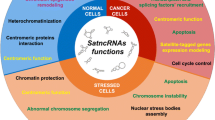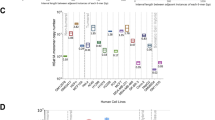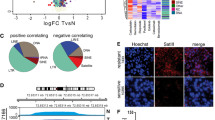Abstract
Recent studies of human and animal tumor tissues revealed a high transcriptional activity of pericentromeric satellite DNA repeats; i.e., they were found to produce up to half of all transcripts in tumor cells, which is many times more than in normal cells. It was also found that the two subtypes of satellite DNA (HSATII and GSATII) are transcribed reciprocally, i.e., HSATII transcripts strongly dominate in tumors, while GSATII transcripts are more abundant in the corresponding normal tissues. Since different RNAs are present in blood plasma, and some of them serve as efficient tumor markers, this study was undertaken to evaluate for the first time satellite HSATII and GSATII RNA levels in the plasma of healthy donors and cancer patients. The RT-PCR protocol designed for this purpose enabled detection of both HSATII and GSATII transcripts. It was shown that HSATII transcripts were more abundant than GSATII RNAs in the plasma of healthy donors, and this relationship was inverse in the plasma of cancer patients; these ratios were exactly opposite to those that exist within normal and tumor cells. Some notions concerning the probable origins of circulating satellite RNAs and their role as potential tumor markers are discussed.
Similar content being viewed by others
Abbreviations
- ITP:
-
isotachophoresis
- DGE:
-
digital gene expression
- Ct:
-
threshold cycle (the number of amplification cycles required to reach the threshold fluorescence level, depends logarithmically on the initial template abundance)
- RFU:
-
relative fluorescence unit
References
Britten R.J., Davidson E.H. 1969. Gene regulation for higher cells: A theory. Science. 165, 349–357.
Pasquinelli A.E. 2012. MicroRNAs and their targets: Recognition, regulation and an emerging reciprocal relationship. Nature Rev. Genet. 13, 271–282.
Baer C., Claus R., Plass C. 2013. Genome-wide epigenetic regulation of miRNAs in cancer. Cancer Res. 73, 473–477.
Castel S.E., Martienssen R.A. 2013. RNA interference in the nucleus: Roles for small RNAs in transcription, epigenetics and beyond. Nature Rev. Genet. 14, 100–112.
Pennisi E. 2013. Long noncoding RNAs may alter chromosome’s 3D structure. Science. 340, 910–910.
Fatica A., Bozzoni I. 2014. Long non-coding RNAs: New players in cell differentiation and development. Nature Rev. Genet. 15, 7–21.
Gvozdev V.A. 2013. Regulatory small RNAs. Biochemistry (Moscow). 78, 561.
Huang Y., Wang J.P., Yu X.L., Wang Z. B., Xu T. S., Cheng X. C. 2013. Non-coding RNAs and diseases. Mol. Biol. (Moscow). 47, 465–475.
Andreasen D., Fog J.U., Biggs W. Salomon J., Dahslveen I.K., Baker A., Mouritzen P. 2010. Improved microRNA quantification in total RNA from clinical samples. Methods. 50, S6–S9.
Brunner A., Beck A., Edris B., Sweeney R.T., Zhu S.X., Li R., Montgomery K., Varma S., Gilks T., Guo X., Foley J.W., Witten D.M., Giacomini C.P., Flynn R.A., Pollack J.R., Tibshirani R., Chang H.Y., van de Rijn M., West R.B. 2012. Transcriptional profiling of lncRNAs and novel transcribed regions across a diverse panel of archived human cancers. Genome Biol. 13, R75.
Chang S., Wang R.H., Akagi K., Kim K.A., Martin B.K., Cavallone L., Kathleen Cuningham Foundation Consortium for Research into Familial Breast Cancer (kConFab), Haines D.C., Basik M., Mai P., Poggi E., Isaacs C., Looi L.M., Mun K.S., Greene M.H., Byers S.W., Teo S.H., Deng C.X., Sharan S.K. 2011. Tumor suppressor BRCA1 epigenetically controls oncogenic microRNA-155. Nature Med. 17, 1275–1282.
Gibb E.A., Vucic E.A., Enfield K.S.S., Stewart G.L., Lonergan K.M., Kennett J.Y., Becker-Santos D.D., MacAulay C.E., Lam S., Brown C.J., Lam W.L. 2011. Human cancer long non-coding RNA transcriptomes. PLoS ONE. 6, e25915.
Burgess D.J. 2011. Chromosome instability: Tumorigenesis via satellite link. Nature Rev. Cancer. 11, 158–159.
Ting D.T., Lipson D., Paul S., Brannigan B.W., Akhavanfard S., Coffman E.J., Contino G., Deshpande V., Iafrate A.J., Letovsky S., Rivera M.N., Bardeesy N., Maheswaran S., Haber D.A. 2011. Aberrant overexpression of satellite repeats in pancreatic and other epithelial cancers. Science. 331, 593–596.
Sheinerman K.S., Tsivinsky V.G., Umansky S.R. 2013. Analysis of organ-enriched microRNAs in plasma as an approach to development of Universal Screening Test: feasibility study. J. Transl. Med. 11, 304–311.
Nikitina I.G., Sabirova E.Yu., Karpov V.L. Lisitsyn N.A., Beresten S.F. 2013. The role of exosomes and microvesicules in carcinogenesis. Mol. Biol. (Moscow). 47, 668–673.
Gusachenko O.N., Zenkova M.A., Vlassov V.V. 2013. Nucleic acids in exosomes: Disease markers and intercellular communication molecules. Biochemistry (Moscow). 78, 1–7.
Gerlinger M., Rowan A.J., Horswell S. et al. 2012. Intratumor heterogeneity and branched evolution revealed by multiregion sequencing. N. Engl. J. Med. 366, 883–892.
Swanton C. 2012. Intratumor heterogeneity: Evolution through space and time. Cancer Res. 72, 4875–4882.
Fisher R., Pusztai L., Swanton C. 2013. Cancer heterogeneity: Implications for targeted therapeutics. Br. J. Cancer. 108, 479–485.
Diaz L.A., Jr., Williams R.T., Wu J., Kinde I., Hecht J.R., Berlin J., Allen B., Bozic I., Reiter J.G., Nowak M.A., Kinzler K.W., Oliner K.S., Vogelstein B. 2012. The molecular evolution of acquired resistance to targeted EGFR blockade in colorectal cancers. Nature. 486, 537–540.
Narayan A., Carriero N.J., Gettinger S.N., Kluytenaar J., Kozak K.R., Yock T.I., Muscato N.E., Ugarelli P., Decker R.H., Patel A.A. 2012. Ultrasensitive measurement of hotspot mutations in tumor DNA in blood using error-suppressed multiplexed deep sequencing. Cancer Res. 72, 3492–3498.
Takeshita N., Hoshino I., Mori M., Akutsu Y., Hanari N., Yoneyama Y., Ikeda N., Isozaki Y., Maruyama T., Akanuma N., Komatsu A., Jitsukawa M., Matsubara H. 2013. Serum microRNA expression profile: miR-1246 as a novel diagnostic and prognostic biomarker for oesophageal squamous cell carcinoma. Br. J. Cancer. 108, 644–652.
Zen K., Zhang C.Y. 2012. Circulating microRNAs: A novel class of biomarkers to diagnose and monitor human cancers. Med. Res. Rev. 32, 326–348.
Lipson D., Raz T., Kieu A., Jones D.R., Giladi E., Thayer E., Thompson J.F., Letovsky S., Milos P., Causey M. 2009. Quantification of the yeast transcriptome by single-molecule sequencing. Nature Biotechnol. 27, 652–658.
Chomczynski P., Sacchi N. 2006. The single-step method of RNA isolation by acid guanidinium thiocyanate-phenol-chloroform extraction: twenty-something years on. Nature Protoc. 1, 581–585.
Kondratova V.N., Botezatu I.V., Shelepov V.P., Lichtenstein A.V. 2011. Tube gel isotachophoresis: A method for quantitative isolation of nucleic acids from diluted solutions. Anal. Biochem. 408, 304–308.
Rozen S., Skaletsky H. 2000. Primer3 on the www for general users and for biologist programmers. In: Bioinformatics Methods and Protocols: Methods in Molecular Biology, vol. 132. Eds Krawetz S., Misener S. Totowa, NJ: Humana Press, pp. 365–386.
Marullo M., Zuccato C., Mariotti C., Lahiri N., Tabrizi S.J., Di D.S., Cattaneo E. 2010. Expressed Alu repeats as a novel, reliable tool for normalization of real-time quantitative RT-qPCR data. Genome Biol. 11, R9.
Lekanne Deprez R.H., Fijnvandraat A.C., Ruijter J.M., Moorman A.F. 2002. Sensitivity and accuracy of quantitative real-time polymerase chain reaction using SYBR green I depends on cDNA synthesis conditions. Anal. Biochem. 307, 63–69.
Liss B. 2002. Improved quantitative real-time RT-PCR for expression profiling of individual cells. Nucleic Acids Res. 30, e89.
Bustin S.A., Benes V., Garson J.A., Hellemans J., Huggett J., Kubista M., Mueller R., Nolan T., Pfaffl M.W., Shipley G.L., Vandesompele J., Wittwer C.T. 2009. The MIQE guidelines: Minimum information for publication of quantitative real-time PCR experiments. Clin.Chem. 55, 611–622.
Vandesompele J., De P.K., Pattyn F., Poppe B., Roy N.V., De Paepe A., Speleman F. 2002. Accurate normalization of real-time quantitative RT-PCR data by geometric averaging of multiple internal control genes. Genome Biol. 3, research0034.1–research0034.11
Cerkovnik P., Perhavec A., Zgajnar J., Novakovic S. 2007. Optimization of an RNA isolation procedure from plasma samples. Int. J. Mol. Med. 20, 293–300.
El-Hefnawy T., Raja S., Kelly L., Bigbee W.L., Kirkwood J.M., Luketich J.D., Godfrey T.E. 2004. Characterization of amplifiable, circulating RNA in plasma and its potential as a tool for cancer diagnostics. Clin. Chem. 50, 564–573.
Kondratova V.N., Botezatu I.V., Shelepov V.P., Lichtenstein A.V. 2009. Isotachophoresis of nucleic acids in agarose gel rods. Biochemistry (Moscow). 74, 1285–1288.
Author information
Authors and Affiliations
Corresponding author
Additional information
Original Russian Text © V.N. Kondratova, I.V. Botezatu, V.P. Shelepov, A.V. Lichtenstein, 2014, published in Molekulyarnaya Biologiya, 2014, Vol. 48, No. 6, pp. 999–1007.
Rights and permissions
About this article
Cite this article
Kondratova, V.N., Botezatu, I.V., Shelepov, V.P. et al. Satellite DNA transcripts in blood plasma as potential markers of tumor growth. Mol Biol 48, 878–885 (2014). https://doi.org/10.1134/S0026893314060089
Received:
Accepted:
Published:
Issue Date:
DOI: https://doi.org/10.1134/S0026893314060089




